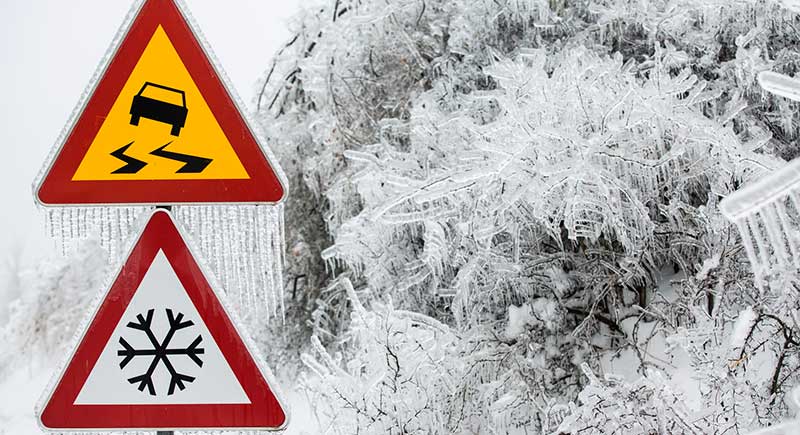Winter Driving can be challenging, in fact it can be out and out terrifying if you get caught in a bad situation. Prepare by winterizing your vehicle before bad weather hits. Have your car’s tires and tire pressure, brakes, heater/defroster, wipers, battery, oil, radiator, ignition system and belts and hoses checked. You may choose to have winter tires or have chains put on the tires you have, depending on where you live. Always have enough gas – at least half a tank in your vehicle.
Did you know that tire tread depth is very important when driving in snow and ice. If your tread is getting shallow, don’t chance it, get new tires. Tire pressure will actually go down in the winter and just the opposite in the summer. If your tire is under-inflated it can affect your steering, not allowing it to respond as quickly as you might need. Your tires lose one to two PSI every time the temperature goes down 10 degrees. Check your tire pressure often during cold weather, adding air as needed to keep your tire at the recommended inflation levels .
Winter Driving Tips Infographic
As you know braking distance is greatly affected by rain, this is also true with snow and ice. As the road becomes covered, your wheels do not touch the road properly resulting in loss of traction. This of course can cause you to hydroplane, slip and slide on the road into another car, guard rail or off the road into a ditch. Scary stuff.
Tips for driving in snow
Tips for driving in snow and on slippery winter roads:
- Remain alert, stay focused and distraction free
- Watch your speed, be mindful of road conditions
- Control your vehicle, knowing how and when to apply your brakes
Plan your route
Shady areas and bridges can be very dangerous as these areas are cooler and can harbor “black ice”. Black ice is extremely dangerous as it is almost impossible to see, suddenly you realize your car is sliding. When you are driving through either of these areas always slow your vehicle down, do not slam on your brakes as you are sure to throw yourself into a slide or spin. Simply take your foot off the gas and, if necessary, tap your brakes to slow your vehicle so you can stay in control of it.
Use snow tires
Snow tires give your car a better chance of maintaining traction. Realize even with them you still have to drive cautiously.
Reduse your speed
Reduce your speed. There is no speed that can be considered safe, but a general rule of thumb is that drivers should reduce their overall speed to half the posted limit and even less if in snowy road conditions. Proceed carefully while you determine the level of traction your tires have on the road, and remember that can change quickly.
Double Distance
Always keep several car lengths between you and the vehicle in front of you. This gives you ample time to slow down if they lose control of their vehicle. So many collisions can be avoided if you have the space to slow down or get into the lane beside you to avoid another car in distress. Statistics say that you should begin slowing your automobile three times sooner than normal before stopping or turning.
Clean the Windows
Scrape all your windows before starting out and keep them defrosted and clean. This enables you to see anything coming at you as well as not spraying snow to other drivers behind you and inhibiting their vision. Make sure your front and rear defrosters are in prime working order and your wipers also have to be operating properly. This means that wiper blades should be well maintained both front and back if applicable.
While the road crews are out working hard to make the roads drivable, knowing salt and sand have been applied is not a license to speed. Salt does prevent ice and snow from adhering to the road surface and is normally applied early if a storm is expected. Sand does not melt snow, but can help provide some additional traction. Sand is used when temperatures are too low for salt to be effective, but does give you a traction boost for when the roads are covered. You will see sand being used on hills, curves, bridges, intersections and snow packed roads.
Knowing how to drive on icy roads can be tricky, remember to be cautious and if possible, stay home.


